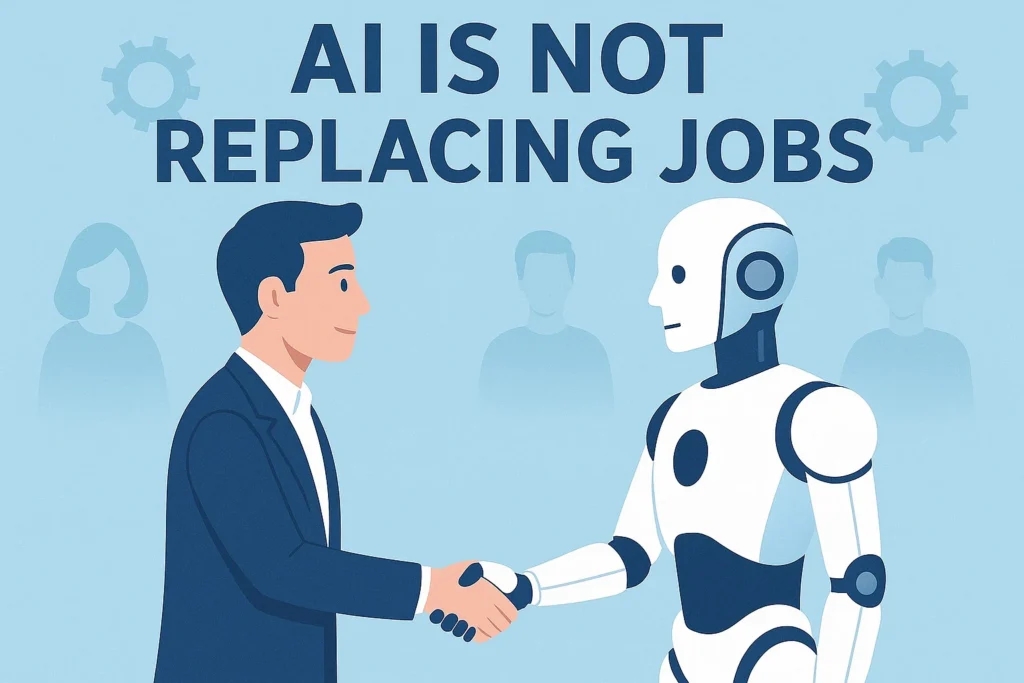Why Youths Shouldn’t Fear AI : In the 21st century, Artificial Intelligence (AI) has emerged as a transformative force, revolutionizing industries, education, healthcare, finance, and even creative fields. From chatbots assisting customers to AI-driven diagnostics in hospitals, the reach of AI has become undeniable. While this technological revolution brings efficiency, innovation, and global connectivity, it also generates fear—particularly among youths who are stepping into the job market.

A widespread concern is: “Will AI replace my job?” It’s a valid question given the rapid automation of routine tasks. However, the narrative that AI will replace humans entirely is misleading. The truth is, AI is designed to complement human intelligence, not replace it. It creates new opportunities, transforms existing roles, and rewards those who adapt and learn its applications.
This article delves into why youths should embrace AI, how it can enhance careers, and practical steps to build a future-proof skillset.
The Root of Fear: Why Youths Worry About AI
Understanding the fear surrounding AI requires examining the social, economic, and technological context.
1. Automation of Routine Jobs
Many traditional jobs are being automated, causing anxiety. For example:
- Retail: Self-checkout counters and AI inventory management.
- Manufacturing: Robotics in assembly lines reducing manual labor.
- Customer Service: Chatbots and automated ticketing systems replacing frontline staff.
Young people entering these sectors may feel that their career paths are shrinking before they even begin.
2. Rapid Technological Change
AI is evolving at an unprecedented speed. Tools like ChatGPT, DALL·E, and advanced predictive analytics perform tasks that once required specialized human skills. Keeping pace with this rapid innovation is challenging, which intensifies fear.
3. Misconceptions About AI
A significant driver of fear is misunderstanding AI. Many believe AI can “think” or “feel” like humans. In reality, AI processes data and recognizes patterns—it doesn’t possess intuition, empathy, or moral reasoning. Without clarity on AI’s limitations, fear is natural but often exaggerated.
Debunking the Myth: Why AI Will Not Replace Humans
AI is a powerful tool but not a replacement for human intelligence. Here’s why:
1. Creativity and Innovation Remain Human
AI can generate art, music, and designs based on patterns, but creativity in context, cultural significance, and emotional depth remains uniquely human. For example, an AI-generated song might mimic styles, but composing a piece that resonates emotionally and culturally requires human insight.
2. Emotional Intelligence and Empathy
Professions like healthcare, counseling, and leadership require emotional connection. A doctor can use AI to analyze medical scans, but empathizing with patients, explaining treatment options, and providing comfort is irreplaceably human.
3. Critical Thinking in Complex Situations
AI excels at data processing but struggles with ambiguity or unprecedented scenarios. Problem-solving often requires reasoning, ethical judgment, and adaptability—skills that AI lacks.
4. Ethical Decision-Making
AI doesn’t inherently understand ethics or social norms. Lawyers, policymakers, and leaders make value-based decisions informed by societal context. AI can assist but cannot replace this responsibility.
Opportunities AI Creates for Youths
Instead of fearing AI, youths can seize numerous opportunities it creates:
1. AI-Centric Careers
AI has generated entirely new career paths, including:
- AI Engineers and Developers: Designing algorithms and neural networks.
- Data Scientists and Analysts: Interpreting complex datasets.
- AI Ethicists: Ensuring responsible and unbiased AI applications.
- AI Trainers: Curating data to train AI models.
These roles are in high demand and often pay significantly above average.
2. Augmentation Roles
AI complements human roles, enhancing productivity and impact:
- Healthcare: AI aids diagnosis, but doctors interpret and treat.
- Finance: AI predicts trends, but analysts strategize investments.
- Education: AI personalizes learning, but teachers mentor and inspire.
- Creative Industries: AI helps generate ideas; humans refine and innovate.
3. Entrepreneurial Opportunities
AI democratizes entrepreneurship. Young innovators can leverage AI to:
- Build apps with AI-powered features.
- Develop AI-driven solutions for social issues.
- Launch startups with minimal initial infrastructure.
This empowerment is unprecedented in history, offering creative and financial freedom.
How Youths Can Prepare for an AI-Driven Future
Preparation is the key to thriving in an AI-enhanced world. Here’s a step-by-step guide:
Step 1: Acquire AI Literacy
Understanding AI fundamentals is crucial. Learn:
- Machine learning, neural networks, and deep learning.
- Natural language processing (NLP) and computer vision.
- Robotics and automation principles.
Actionable Tips:
- Online courses: Coursera, edX, Udemy.
- Books: “Artificial Intelligence: A Modern Approach” (Russell & Norvig).
- Blogs, YouTube tutorials, and AI newsletters.
Step 2: Develop Technical Skills
Even basic programming knowledge gives an advantage. Focus on:
- Languages: Python, R, Java.
- AI Frameworks: TensorFlow, PyTorch, Keras.
- Data Tools: Excel, SQL, Tableau, Power BI.
Practical projects—like building a chatbot or analyzing a dataset—reinforce learning.
Step 3: Build Soft Skills
Soft skills cannot be automated and are highly valuable:
- Communication and interpersonal skills.
- Critical thinking and problem-solving.
- Creativity and innovation.
- Leadership and collaboration.
These skills help you adapt AI tools effectively and lead in any environment.
Step 4: Engage in Lifelong Learning
AI evolves rapidly. Stay updated by:
- Following AI research and tech blogs.
- Joining AI communities and forums.
- Participating in hackathons and workshops.
Adaptability ensures long-term career resilience.
Real-Life Case Studies of AI Empowering Humans
Case Study 1: Healthcare
AI tools analyze X-rays, MRIs, and patient data for faster diagnosis. Human doctors interpret results, interact with patients, and create personalized treatment plans, combining AI precision with human empathy.
Case Study 2: Finance
AI models detect fraudulent transactions and forecast market trends. Financial advisors use these insights to guide clients, combining AI analytics with human judgment.
Case Study 3: Education
AI platforms personalize lessons for students based on performance. Teachers still mentor, motivate, and teach critical thinking, demonstrating the irreplaceable role of human guidance.
Case Study 4: Creative Industries
AI helps designers generate prototypes, writers draft content, and filmmakers storyboard ideas. Humans apply artistic vision, storytelling, and cultural nuance to refine outputs.
Practical Steps to Integrate AI Into Career Growth
- Experiment with AI Tools: Explore platforms like ChatGPT, MidJourney, and coding assistants.
- Participate in AI Projects: Internships, research programs, or personal projects enhance experience.
- Focus on Hybrid Roles: Skills combining human creativity with AI analysis are increasingly valuable.
- Stay Future-Focused: Anticipate how AI may change industries and align your skills accordingly.
The Future: Collaboration Between Humans and AI
The workplace of tomorrow will not feature humans versus AI but humans augmented by AI. Benefits include:
- Increased productivity and efficiency.
- Enhanced decision-making based on insights.
- Opportunities to innovate and create new products or services.
Key Takeaway: Embrace AI as a partner rather than a competitor. Curiosity, adaptability, and continuous learning will define success.
Inspirational Insights for Youths
- Fear Is Natural, But Knowledge Is Power: Understanding AI dispels myths and builds confidence.
- Adaptation Is Essential: Those willing to learn and integrate AI will lead, not lag.
- Human Uniqueness Matters: Creativity, empathy, ethics, and problem-solving remain irreplaceable.
- Opportunities Outnumber Threats: Every technological shift has created more jobs than it destroyed.
Conclusion
Artificial Intelligence is not a threat but a catalyst for human growth and innovation. While fears of job loss exist, history demonstrates that technology reshapes industries rather than eliminating human relevance. For today’s youth, the path is clear: learn AI, leverage its strengths, and cultivate human-centric skills.
By doing so, young professionals can:
- Access high-demand AI-related careers.
- Augment their capabilities for superior performance.
- Create entrepreneurial ventures and innovative solutions.
- Remain adaptable in a fast-changing job market.
The future belongs to those who see AI as an opportunity, not a threat. For youths, the message is empowering: embrace AI, stay curious, and your career potential is limitless.

I enjoyed the case study — it really brought the theory to life.
Fantastic resource. Do you offer a PDF version of this post?
Insightful post — I’d be interested in a follow-up on advanced topics.
This topic is so relevant right now. Thanks for the timely post.
Nice post. I learn something totally new and challenging on websites
Nice balance of theory and practical advice. Well done!
Thanks for the breakdown — the comparisons were particularly useful.